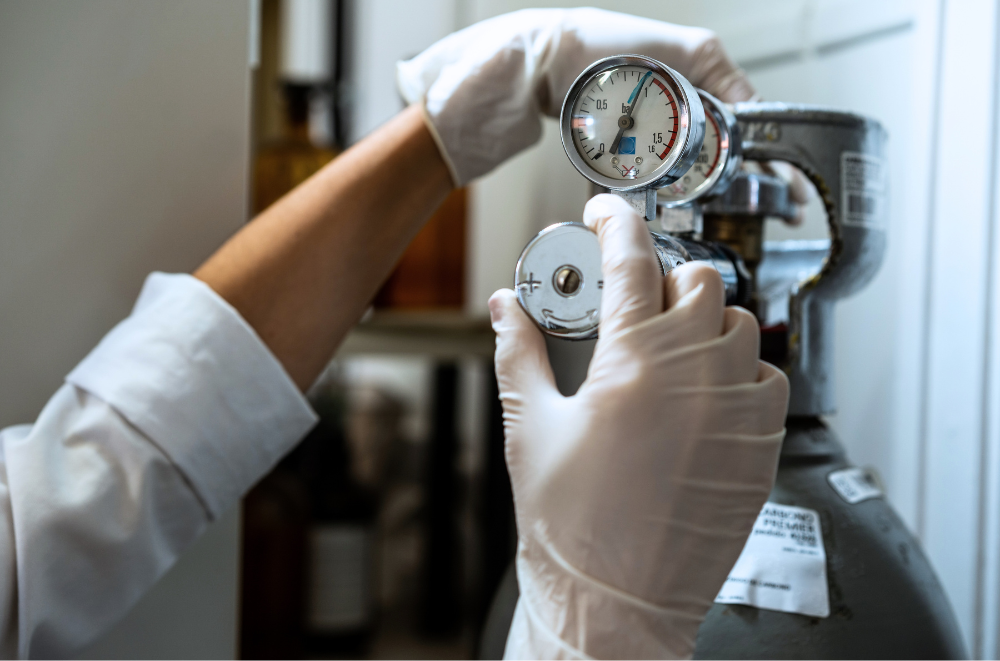
This year, Organomation conducted a nationwide survey to better understand how laboratories across the U.S. source, spend, and strategize around their nitrogen supply. The survey reached professionals across academic, environmental, government, pharmaceutical, and industrial labs—many heavily reliant on nitrogen for sample preparation, chromatography, and analytical instrumentation.
Our goal was simple: uncover the real challenges labs face with nitrogen logistics, cost, and reliability—and determine how facilities are preparing for future demand. While the full survey report is available as a download, several key highlights stood out, revealing trends, frustrations, and opportunities in lab nitrogen management.
How Most Labs Source Nitrogen Today
Despite growing interest in on-site generation, traditional supply methods still dominate:
- 59% of labs rely on high-pressure gas cylinders
- 21% use lab-scale nitrogen generators
- 10% use liquid dewars, with the remaining utilizing bulk or building-wide delivery
Cylinders remain the leading nitrogen supply method likely because they are familiar to lab staff, widely available from multiple vendors, and require minimal setup or infrastructure. Their widespread use reflects a balance of convenience, reliability, and simplicity that many labs prioritize when sourcing nitrogen.
Yet while cylinders are common, survey respondents identified cost as the top challenge across all supply types, highlighting that even widely used methods can carry significant financial and logistical considerations.
Cost: The Leading Frustration Across All Supply Types
When asked to rank their top nitrogen challenges, cost emerged as the number one concern, ahead of supply availability, logistics, and safety. This aligns with a core finding in the report: Labs are spending an average of $851.85 per month on nitrogen — approximately $2.27 per liter.
However, cost per liter varies widely depending on the source:
| Supply Type | Avg. Cost per Liter |
|---|---|
| Gas Cylinders | $2.79 / L |
| Liquid Dewars | $2.06 / L |
| Lab-Scale Generators | $0.70 / L |
This data reveals a striking gap: Nitrogen generators are 75% more affordable than cylinders and 66% cheaper than liquid dewars, highlighting a major potential for long-term savings.
The differences in cost per liter underscore how nitrogen sourcing choices can have a significant impact on monthly and annual lab budgets. While cylinders remain the most commonly used supply method, liquid dewars and lab-scale generators clearly offer more economical options, particularly for labs with higher consumption or frequent use. The survey results suggest that labs evaluating their supply strategy may find substantial savings simply by comparing per-liter costs and usage patterns across different sources.
See our full TCO analysis comparing nitrogen generators and gas cylinders for more information.
A Growing Need for Sustainable Supply
Another key trend from the survey: 96% of labs expect their nitrogen usage to either increase or remain steady over the next three years. As demand grows and budgets remain flat, labs are feeling pressure to find more efficient and reliable supply solutions.
- 73% of labs currently fund nitrogen directly from their operating budget, meaning any inefficiencies or unexpected costs directly reduce funds available for critical equipment, consumables, or staffing.
- With these budgetary pressures in mind, many labs are evaluating ways to improve supply security, reduce recurring costs, and future-proof their operations against rising demand.
Beyond Cost: Why More Labs Are Considering On-Site Nitrogen Generation
While the financial benefits of nitrogen generators are clear, there are also several potential operational advantages that labs often consider when evaluating on-site generation:
- Uninterrupted supply – On-demand nitrogen can help minimize the risk of delays or interruptions due to delivery schedules or stock shortages.
- Workflow efficiency – Generators may reduce downtime associated with cylinder changeouts, allowing analysts to focus more on critical tasks.
- Space & safety improvements – Eliminating the need to store high-pressure cylinders or cryogenic dewars can free up lab space and reduce handling hazards.
- Purity consistency – On-site generation can provide a consistent supply of high-purity nitrogen, potentially lowering the risk of contamination from transport or handling.
These factors highlight why some labs explore nitrogen generators not only for cost savings but also for operational efficiency, safer lab environments, and more reliable experimental workflows.
Want to See the Complete Data Breakdown?
The full Nitrogen Usage 2025 Survey Report includes:
✔ Detailed monthly cost averages
✔ Supply challenges by source type
✔ Consumption ranges and budget allocation
✔ Future nitrogen demand trends
Download the full report to benchmark your lab and explore the complete analysis.
If you’re rethinking your nitrogen strategy or curious how a generator could impact your bottom line, our team can walk you through your specific usage, identify savings opportunities, and calculate your payback timeline. To see the potential impact for your lab, try our Nitrogen Generator Savings Calculator and explore how much you could save by making the switch.
